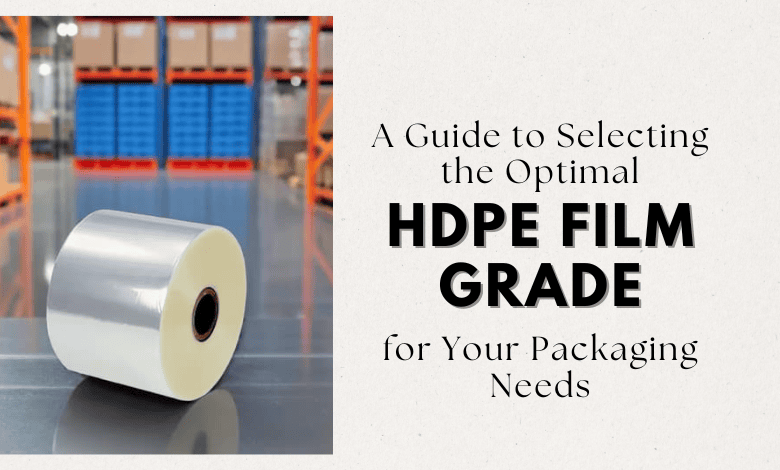A Guide to Selecting the Optimal HDPE Film Grade for Your Packaging Needs

High-Density Polyethylene (HDPE) films are a cornerstone of modern packaging, found in everything from lightweight grocery bags and food wraps to heavy-duty industrial liners. The specific HDPE grade you select is a critical decision, directly impacting your product’s performance, manufacturing efficiency, and environmental footprint.
To navigate this choice effectively, consider the following five key factors.
Analyze the Core Material Properties
HDPE film grades are differentiated by their fundamental properties, which dictate their performance characteristics. Understanding these is the first step to a successful selection.
| Property | Typical Range | Why It Matters |
|---|---|---|
| Density | 0.940–0.960 g/cm³ | Higher density provides superior stiffness, brittleness, and moisture barrier properties, while lower density enhances flexibility and toughness. |
| Melt Flow Index (MFI) | 0.05–1.0 g/10 min | A lower MFI indicates a higher molecular weight, resulting in greater strength and tear resistance. A higher MFI improves processability and ease of extrusion. |
| Tensile & Impact Strength | Application-specific | These properties define the film’s mechanical durability—its resistance to stretching, puncturing, and impact under stress. |
Selection Tip: Prioritize these properties based on your primary need: is it maximum strength, superior clarity, enhanced toughness, or optimal cost-efficiency?
Align the Grade with the Application
Different packaging applications demand different material performances. Match the grade’s strengths to the product’s requirements.
- Thin-Gauge Films (e.g., shopping bags, produce bags): Require high stiffness and excellent drawdown capability. Grades like HDPE 7000F are often engineered for this purpose.
- Food Packaging: Must balance processability, clarity, and critical compliance with food-contact regulations.
- Heavy-Duty Sacks & Industrial Liners: Demand exceptional impact and puncture resistance, typically provided by higher molecular weight (lower MFI) grades.
- Multilayer Films: Often co-extrude HDPE with other polymers like LLDPE to combine HDPE’s stiffness and moisture barrier with the enhanced sealability and toughness of LLDPE.
Consider Your Processing Method
Your manufacturing equipment places specific demands on the resin. Ensure your chosen grade is compatible with your production line.
- Blown Film Lines: Require grades with excellent melt strength for stable bubble formation and consistent gauge control.
- Cast Film Lines: Benefit from grades with superior melt uniformity to ensure a smooth, high-clarity surface finish.
- Co-extrusion Systems: Need grades that are compatible with adjacent layers in terms of melt temperature and viscosity to prevent delamination.
Matching the resin’s MFI to your equipment’s speed and die design is crucial for maximizing output and minimizing production issues like gels or uneven thickness.
Verify Regulatory and Safety Compliance
For food, medical, or consumer-facing packaging, regulatory compliance is non-negotiable. Ensure your selected HDPE grade meets the necessary standards for your market.
Key regulations include:
- FDA 21 CFR 177.1520 (U.S. food contact)
- EU Regulation No 10/2011 (European food contact plastics)
- REACH & RoHS (Restrictions on hazardous substances)
Always request and review a Certificate of Compliance (CoC) or relevant testing reports from your material supplier.
Factor in Sustainability Goals
Sustainable packaging is no longer optional. Selecting the right HDPE grade can significantly advance your environmental objectives. Look for grades that:
- Enable the creation of fully recyclable mono-material structures.
- Are compatible with Post-Consumer Recycled (PCR) content for circularity.
- Facilitate lightweighting—reducing film gauge without sacrificing strength—to minimize material use and waste.
Choosing a recyclable HDPE grade not only reduces your carbon footprint but also aligns your brand with the principles of a circular economy.
Making the Final Decision
Selecting the ideal HDPE film grade is a balancing act between mechanical properties, processability, compliance, and sustainability. A thorough understanding of these parameters ensures consistent product performance and cost-effective production.
When sourcing materials, partnering with a reliable supplier is key. Suppliers like Retrona offer advanced HDPE film grades, such as their 7000F, which are engineered to deliver consistent, high-performance results across a wide spectrum of packaging applications.








